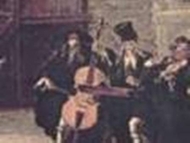Welcome to your source for designer Israeli Jewelry and Gifts. Buy and enjoy your chic and special jewels from the comfort of your home or mobile.
Welcome to our new site: https://sterlingsilverjewel.com
Jewish Traditional & Israeli Music
Israeli Jewelry - Israel Gifts
About Israeli History and Culture
Zionist settlement in Palestine (as the country was called during the centuries when it was part of the Ottoman Empire and later the British Mandate) began in the last two decades of the nineteenth century and continued with further waves of Jewish immigration during the thirty years of British rule after World War I. These are conventionally known as the five waves of ʿaliyah—that is, the “first ʿaliyah, ” the “second ʿaliyah, ” and so on.
By 1948, when the State of Israel was established as a Jewish state and fought its War of Independence, there were some 600,000 Jews in Israel, the overwhelming majority of whom came from countries in Eastern and Central Europe.
By 1952, the Jewish population had almost tripled with the arrival of more European Jews (many of them Holocaust survivors) and, most significantly, large waves of immigration from Arab and Muslim countries (Yemen, Iraq, and Morocco were among the largest).
The Jewish population of Israel numbered approximately five million, and the Arab-Palestinian minority, one million.
Israeli Music CDs DVDs
Defined as a “Jewish state, ” Israel has adapted Jewish religion, tradition, symbolism, and mythology to its modern, secular nationalistic purposes.
But Zionism, as a set of cultural practices in Palestine and later in Israel, evolved around two major, interrelated themes: the rejection of the culture of the Jewish Diaspora (the galut, that is, the existence of Jews in scattered communities in many different countries) and the invention of a “new” Jew, the Hebrew person, the Israeli.
Early Hebrew national style The Zionist settlers created a new style of music that would strengthen ties with their Hebrew roots and distinguish them from Diaspora Jewry and its perceived weakness.
The ethos of the Zionist enterprise was linked to the “return to the land” in its most practical sense: to agricultural work, “the blooming of the desert, ” as David Ben Gurion once put it. The Zionist narrative celebrated the agricultural settlement as its most tangible achievement. The culture created in these settlements, especially in the communal kibbutzim, became a model for incoming Jewish immigrants as well as supporters of the Zionist movement outside Palestine, though the majority of the Jewish population both in the Yishuv and abroad belonged to the urban bourgeoisie. Thus the Israeli folk song, that is, Shirei Eretz Yisrael (SLI) and particularly the songs of its golden age (the 1920s to the 1960s), composed in many cases by kibbutz members, became the musical paradigm of the new Hebrew culture.
Elements were borrowed a bit from Arabic music and, to a lesser extent, traditional Yemenite and eastern Jewish music. The songs were often homophonic, modal, and limited in range.
Greek-style bouzouki music became increasingly popular in the early 1960s. Aris San, a non-Jewish Greek singer who moved to Israel and became an Israeli citizen, was the driving spirit behind this trend. One of Aris San's hit songs was "Sigal" (lyrics by Yovav Katz). Aris San, who owned the Zorba club in Jaffa, wrote songs for Aliza Azikri (Bahayim hakol over, Yesh ahava ata omer), that effectively broke down the barriers between Israeli song and the world of Greek and Mizrahi music.
A number of young musicians traveled to South America in the late 1960s, and brought back Latin rhythms and sonorities which became a force in popular music through the 1970s.
The American folk movement of the 1960s and 1970s influenced the Israeli national style, and Israeli folksingers who patterned themselves after Judy Collins and Joni Mitchell.
In the 1960s, guitar duos such as the Dudaim and the Parvarim performed not only "canonical" Israeli songs, but also Hebrew versions of American and British folk songs.
Land of Israel style
Despite the great diversity in Israeli music today, a corpus of canonical songs has developed, known as "Shirei Eretz Yisrael" — "Songs of the Land of Israel" .
These songs, composed from 1920 to the mid-1970s, have certain identifying musical characteristics:
•Use of minor keys. The canonical songs are almost universally in minor. Songs based in the Russian or klezmer traditions normally use the harmonic minor (that is, with an elevated seventh), while songs in the New Hebrew style use natural minor, often with a diminished second leading to the tonic. Songs in this style are also sometimes modal, or semimodal, ending on the dominant rather than the tonic.
SONG OF CAMARADERIE (GURI-ARGOV)
On the Negev the autumn night falls
And gently, gently lights up the stars
When the wind passes through
Clouds wander along the road.
Already a year has elapsed
We practically did not feel
how the time passed in our fields.
Already a year and few of us are left.
So many are no longer among us.
But we will remember them all.
The handsome ones with beautiful curls
Because camaraderie like this
will never allow our hearts to forget.
Love sanctified by blood
Will return to flourish among us.
"At Adama" sung by Ran Eliran
•Hora, debka and other dance rhythms. These dance rhythms often have strong offbeats and asymmetric meters. They accompany popular Israeli folk dances. An example of a debka rhythm is At Adama based on a Bedouin melody, and sung by Ran Eliran.
•Use of the darbuka, the tambourine and other instruments associated with middle eastern music.
•Lyrics that relate to the Israeli experience. As one might expect in a country that has faced major wars and military conflicts since its inception, army life and wars are common themes in Israeli songwriting. Interestingly, very few of the war songs are marching songs, and none denigrate the Arab enemies. Most are melancholy, focusing on separation and loss during war, and the longing for peace. Many songs are about pioneering, building up the land, and love of hiking and nature. Others are based on biblical texts. A typical pioneer marching song is Anu Nihiyeh HaRishonim (We will be the first), with words by Yosef Haftman to a traditional melody.
Tweet
Tweet
Thank YouThank you for visiting our site and hope you will like our jewelry collection: silver jewelry, genuine Roman Glass jewelry, silver and gold spinning rings, Hebrew rings, gemstones necklaces and earrings,and much more.We strive to provide you the best customer service, in addition to top of the line quality products. We will be here for you with any question or need. Don't hesitate to contact us. Distributors and ShopsIf you have a shop or are a distributor, or want to sell our jewels and products at parties, working places, fairs - contact us and we will give you all relevant information and support.ShipmentShipping Information: by Registered Post or by EMS - expedited post.Secure PaymentsWe accept Paypal and main credit cards - Visa and Mastercard. You do not need to have a Paypal account in order to pay with your credit card, and you never share your financial information with anybody using PAYPAL SECURE PAYMENT! |
Tweet







